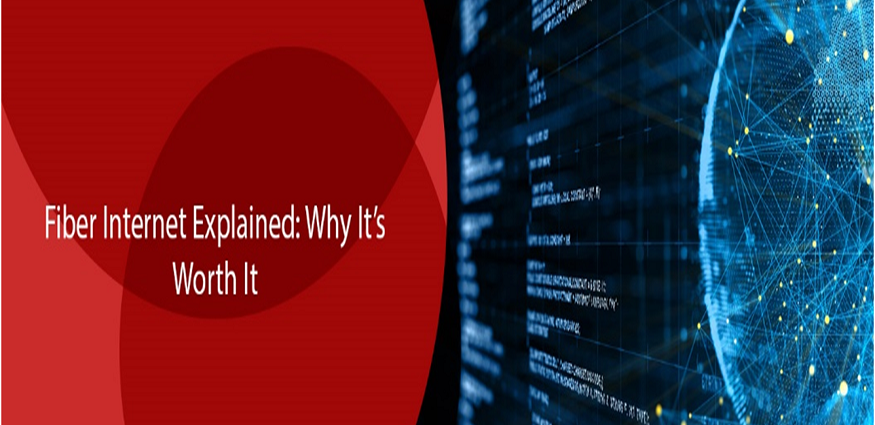Fiber-optic internet is all the rage in telecommunication these days. This new technology uses less power, has a higher bandwidth, and allows faster data transfer speeds compared to all other technologies used today.
On the other hand, fiber-optic cables cost more than coaxial cables, which can make fiber connections costlier. Are fiber connections worth the higher price or should you stick to cable internet?
Experts agree fiber internet is superior to other technologies, and the reason is more than just higher download speeds. Here we explain how optical fibers use light to transmit data and discuss the advantages of fiber internet over other types of connections. Let’s dive right into it!
What is Fiber Internet?
Fiber internet is a type of internet connection that uses infrared light traveling through optical fibers. The idea is that infrared takes less energy to produce than electrical signals. Light waves also don’t dissipate much energy while traveling, unlike electrical signals which need to be amplified after a certain distance.
Light also travels faster than electrical signals, allowing for lower response times. Lastly, fiber-optic cables have a much broader bandwidth compared to coaxial cables, which allows users to access the internet at fast speeds even at peak times.
A fiber internet network uses optical fibers for most connections, ensuring fast, reliable speeds for everyone in the network. For instance, Grande Internet has built a network of fiber-optic cables in Texas for its ultra-fast internet with top speeds ranging from 600 to 1200 Mbps. Visit buytvinternetphone.com to see if Grande Internet is available in your area.
How Do Fiber-Optic Cables Work?
Optical fibers use light to transmit data. Cables have to make all kinds of twists and turns but light travels in straight lines. The only way to change the direction of light is through reflection or refraction.
Why Mirrors Don’t Work
One natural way to make “cables for light” is by using mirrors. A round cable with reflective inside walls should work. It would bounce back any rays of light that go off the track. But mirrors don’t actually reflect 100% of light. Even the shiniest mirrors absorb or let pass a small percentage of light. Cables made from mirrors would lose much of the signal within a kilometer.
Mirrors That Aren’t Mirrors
So what’s the solution? You may have noticed that plane objects other than mirrors can reflect light too, such as your smartphone’s screen. You may have also noticed that this reflectivity is lowest when you’re looking at the screen from the front and increases when you look from steeper angles.
When light is traveling in a dense medium (such as a polymer) and it touches the surface, the reflection is even greater. If the light traveling through the polymer hits at a steep angle, 100% of it can get reflected. This physics phenomenon is known as total internal reflection and is the basis of fiber-optic communication technology.
Bend Radius and Why Optical Fibers Can’t Bend Much
100% reflection means that no amount of light gets out of the fiber-optic cable, allowing for the signal to travel for long distances. However, total internal reflection only works at steep angles. If the cable is bent such that light rays strike the surface at a high angle, they may escape or get absorbed.
This is why fiber-optic cables have a bend radius beyond which they cannot be bent. Scientists are working on developing stronger fiber-optic cables with ever-smaller bend radii so they can be used more widely.
Despite limitations, fiber-optic cables are immensely powerful for communications. Here are a few advantages of fiber-optic internet compared to cable and DSL internet.
Advantages of Fiber-Optic Internet over Cable and DSL
Higher Speeds
Fiber-optic cables can transmit more data per second than coaxial cables. This is why most fiber ISPs including Grande Internet offer speeds much higher than cable or DSL internet. Speeds with fiber internet for residential users can reach 1 Gbps or higher.
Greater Bandwidth
Fiber-optic cables have a much higher bandwidth compared to cable or DSL connections. In peak times when many people are using data, ISPs have to limit the speed for most users because they simply don’t have enough bandwidth to handle that much data. With fiber-optic cables, this is less of a problem. You get nearly the same speed almost all the time.
Low, Consistent Ping
For gamers, the most important quality of an internet connection isn’t speed. It’s ping. Ping is a measure of how long it takes for a user to communicate data with a game server. In competitive multiplayer games, low ping allows gamers to view enemy movement earlier and respond more quickly.
Light travels faster than anything else, including electrical signals. This means that fiber internet can have the lowest ping possible with any type of connection.
Get Grande Internet Today!
Convinced that you need fiber internet? Grander Internet is a popular choice in Texas for its high-speed connections at very reasonable prices. Visit buytvinternetphone.com to learn more.

